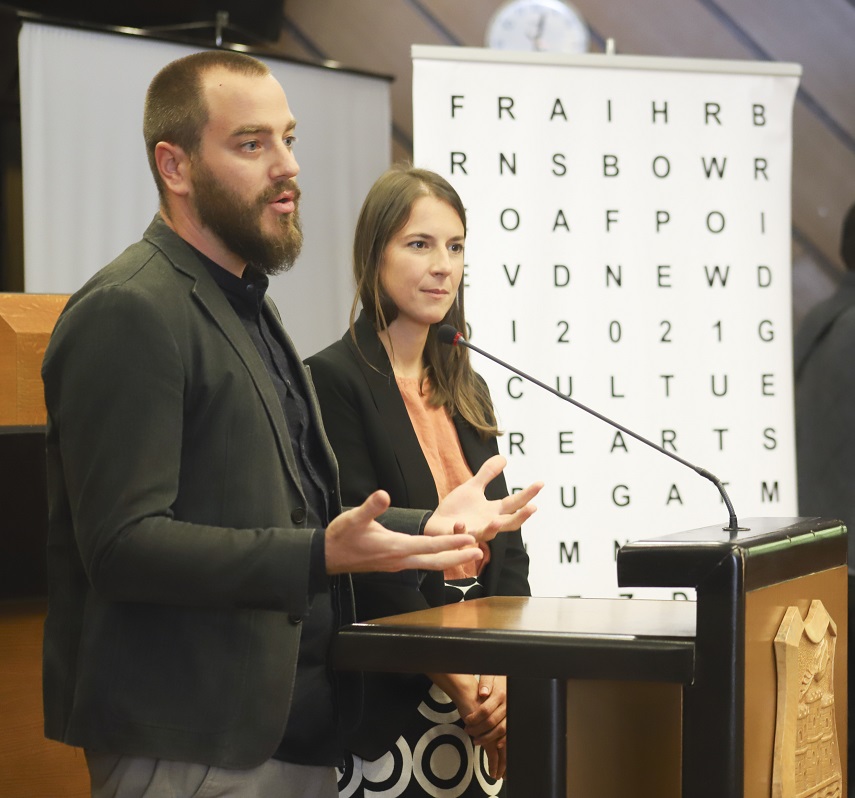Three years after receiving the European Capital of Culture title, Novi Sad became the first city in Serbia having cultural institutions with a five-year work strategy.
The process of education and mentoring for one hundred employees in cultural institutions was implemented by the UNESCO Chair, University of Arts in Belgrade, while the coordination between institutions was conducted by the ‘Novi Sad 2021 – European Capital of Culture’ within the ‘Capacity Building of Cultural Institutions in Novi Sad’ project. According to Goran Tomka and Višnja Kisić, coordinators of the project, the whole process was launched because of the audience itself.
Goran is a docent lecturer at the Faculty of Sports and Tourism in Novi Sad and a visiting lecturer at the UNESCO Chair in Cultural Policy and Management of Academy of Arts in Belgrade and at the University Lyon 2 in France. He is also a co-author of the Strategy of Cultural Development of the City of Novi Sad and concept of application of Novi Sad for the European Capital of Culture. He is an active participant in workshops, seminars and lectures in the field of cultural policies and management in culture in Greece, Lebanon, France, Austria, Spain, Slovenia and Serbia. He is a member of the European Association of Cultural Researchers Steering Committee.
Višnja is Secretary General of the Europa Nostra in Serbia, the biggest European network of civil society in the field of heritage, PhD in History of Art and Management of Cultural Heritage. She is an associate at the Centre for Museology and Heritology, teaches at the UNESCO Master Programme in Cultural Policy and Management at the University of Arts in Belgrade, and is a visiting lecturer at the University Lyon 2 (France), Uppsala University (Sweden) and Hasan II University (Morocco). She is the holder of the National Museum Award 2009 and the prestigious European Cultural Policy Award CPRA 2013.
‘From the beginning the idea was to expand access to cultural content and increase audience participation. How can we plan what we will do in a year, two or three, keeping in mind who will be there to watch, listen, work with us? The public can now expect greater transparency of the work of the institutions, what is happening, what the funds are spent on, and therefore there is greater trust between cultural institutions and the audience, i.e. cultural institutions exist because of citizens’, explains Goran Tomka.

– What do the five-year strategies bring to the cultural institutions themselves?
GORAN: It is very important for institutions that their employees, partners and administration move together in one direction, i.e., that we have some kind of harmonisation and coordination of work. It also opens the door to institutions, when it comes to some additional funds, networks, associations, because everyone wants you to have a strategic plan. Now employees can expect that some of their projects will actually implement, not in the short term, but that there is some plan for a longer period.
– Plans for the next five years have been adopted. What is the next step?
VIŠNJA: Now we are in a period in which the institutions implement what they have planned with the support of the City and the Province. According to the Laws of the Republic of Serbia, all public institutions make plans on a one-year basis, so it is now necessary to align the five-year plan with that. I think it is extremely important that the support from the City and the Provincial Secretariat continue, to be constant and obvious, both in budgetary and moral terms.

– What was the work with the representatives of the institutions like? What was their knowledge and experience?
VIŠNJA: It is extremely important that different institutions have participated. From cultural centres in Futog and Rumenka, to the Serbian National Theatre, Museums, Youth Theatre and others. Therefore, their experiences are diverse. They all came with some specific prior knowledge, but it seems to me that few have had the opportunity to go through the strategic planning process. I think everyone has enjoyed this work that lasted almost a year, because there are few opportunities where representatives of cultural institutions, as well as the civil sector, learn, work and discuss together. This has helped to build up some trust, create some new connections and ideas of who to work with. We made the work of institutions much more transparent.

– In addition to this project, you also worked on the ‘Audience in Focus’ and the ‘Case Petrovaradin’ projects as part of the preparation of Novi Sad for the European Capital of Culture. How much do all these projects contribute to the cultural scene and preparation for 2021?
VIŠNJA: We have approached each of these projects in a sense that they are prepared for 2021, but not that the year is the goal itself. The goal was to make each project a new basis. The ‘Audience in Focus’ is the basis for public relations and some new ways of cooperation, the basis for the Strategic Planning Project is to design the work of institutions, and in the ‘Case Petrovaradin’ project, the plan is to establish and introduce for the first time in our region the approach to managing the historical heritage.
GORAN: The norm of the European Capital of Culture is to deal with the structure and infrastructure of the cultural scene. That was exactly the goal of the project we are mentioning. Not only we are producing new content, but exploring ourselves, our system and making things better. Who lacks the support, what knowledge we have, how we can approach the audience and some marginalised groups with new tools, thinking and methodology, to cooperate better, i.e., to change the cultural offer and production of Novi Sad thoroughly and systematically. It is not something that is very popular, that is visible at first glance and that the audience immediately learns, but that is the reason it is important. Festivals and events come and go, but the quality of reflection and production and culture in general in one society comes through seminars, meetings, travels, learning, and these projects provide exactly that.
– Where does Novi Sad stand now compared to before, in light of these changes in the field of culture?
VIŠNJA: We raised some questions that were kept under the rug and in some comfort zone for a long time – we do what we do and nobody asks questions. This has changed, there is some ambition, in which many are involved and in which more people will need to get involved, but the things have ‘shaken off’ in the field of culture. For the first time, culture has gained an important place in media, in constant discussions among citizens. The title of the European Capital of Culture has also encouraged those who were not asked a thing, to be interested in what is going on. Every progress is positive, but there are many more areas that could be worked on and that will be worked on in the coming period.
GORAN: I think we have made some very important steps, collaborations that have not existed. People who should meet all the time are connected now. Some visions have emerged, we have identified the problems we need to deal with. Some kind of light is on, now we know ourselves and others better, some further directions have been set, some capacities have been strengthened and I think we are on the right track to make the cultural production of Novi Sad better. This does not mean that the job is done, it will not be finished even in 2021 because there is always room for improvement and work.



